14 Key
AI Patterns
for Designers Building
Smarter AI Interfaces
.webp&w=3840&q=100)
Did you know Netflix has been using machine learning to recommend content since 2012?
By 2013 Google was already sorting emails into categories like “Primary”, “Social” and “Promotions” using AI technology to enhance their sorting processes.
And in 2014 Uber Eats was using AI to optimize delivery routes to reduce delivery times.
AI has been in our lives for over 10 years but it's only recently become a buzzword. Every tech giant is talking about it but the real question is—are we happy with it?
AI tools are now assisting in UX design and research, streamlining processes and generating insights.
For every successful Gmail filter we still have Gemini's quirks. Just goes to prove how AI alone isn't the magic bullet.
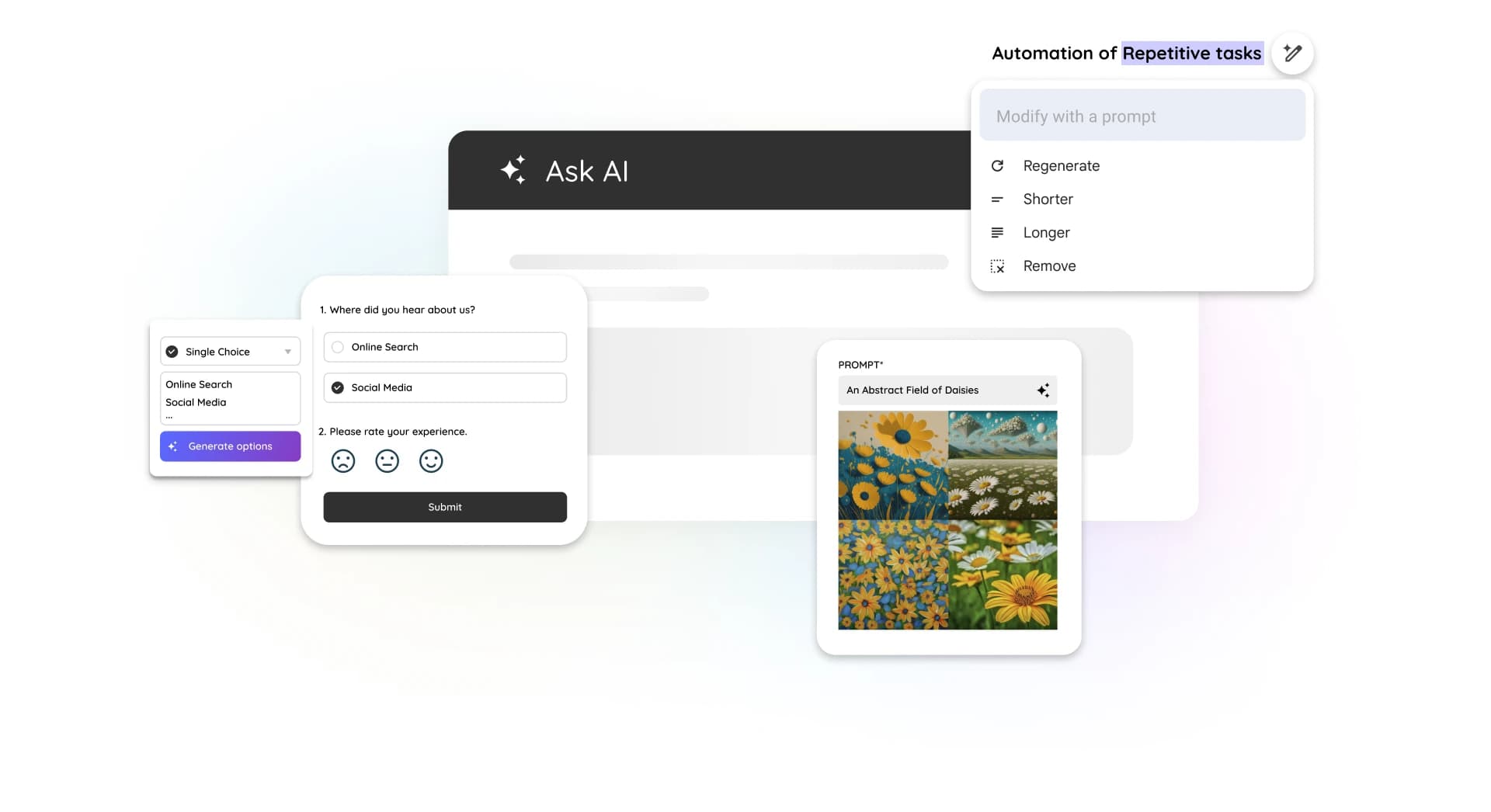
Principles for Human-Centered AI Design for UX Designers
Adding features isn’t enough to create good AI. You need to design the whole experience—from the design process to the interaction flow.
AI must be clear, transparent, and intuitive, with a user interface that streamlines workflows and adjusts to user intentions. It must give users control and most importantly be designed to avoid bias and privacy issues.
To help us with this we need principles—our North Star—like Google’s AI Principles, or Mircosoft’s HAX Toolkit. These guardrails ensure AI systems are safe, fair and aligned with human values.
AI experiences should:
- Be free from bias that harms or marginalizes users.
- Be intuitive and transparent, not unpredictable.
- Be explainable so users understand the decisions.
- Respect privacy and be secure, hold systems accountable for their outputs.
14 AI Patterns For Designing Seamless AI Experiences
AI patterns are design solutions to common AI challenges like user trust, decision making, or error recovery, often leveraging AI tools to automate routine tasks and enhance workflow efficiencies. They are blueprints for integrating AI into user-friendly and reliable applications.
They’re composed of 14 patterns (guidelines) to assist in:
- Defining AI’s behavior to help conceptualize what the AI will do, and how it will behave in different scenarios.
- Creating AI products that are user-friendly, transparent, and reliable.
- Helping users trust and understand the AI's decision-making process.
PATTERN 1
Refine Output

What is it?
Refine Output allows users to fine-tune AI-generated content quickly through contextual menus or selection-based actions. Users can adjust the output to better align with their preferences, objectives, or content accuracy without re-running or retraining the AI model.
Why is it important?
It gives users more control over the AI’s output, enabling them to adjust and improve results on the fly. It enhances the usability and trustworthiness of AI systems by allowing users to tweak results based on personal or business needs.
Implementation Tips
- Create a user interface for easy text selection or content highlighting.
- Implement contextual menus that appear when content is selected.
- Offer specific refinement options, such as "regenerate," "make longer," "make shorter," "change tone," etc.
- Ensure the AI can process these refinement requests and generate updated content accordingly.
- Allow for iterative refinement, where users can continue to modify the updated content.
Healthcare use cases + Real life examples
- 1.Documentation Assistant: This assistant passively captures relevant patient information during consultations, thus reducing the need for active documentation. It understands and adapts to different clinical scenarios to provide relevant and timely suggestions, automates routine tasks, and ensures accuracy in documentation.
- 2. Customer Support: A chatbot suggests responses, and the support agent uses Refine Output to adjust the suggested answer to sound more polite or detailed before sending it to a customer.
- 3.Gemini: Allows users to select text and choose actions like regenerate or make it longer or shorter.
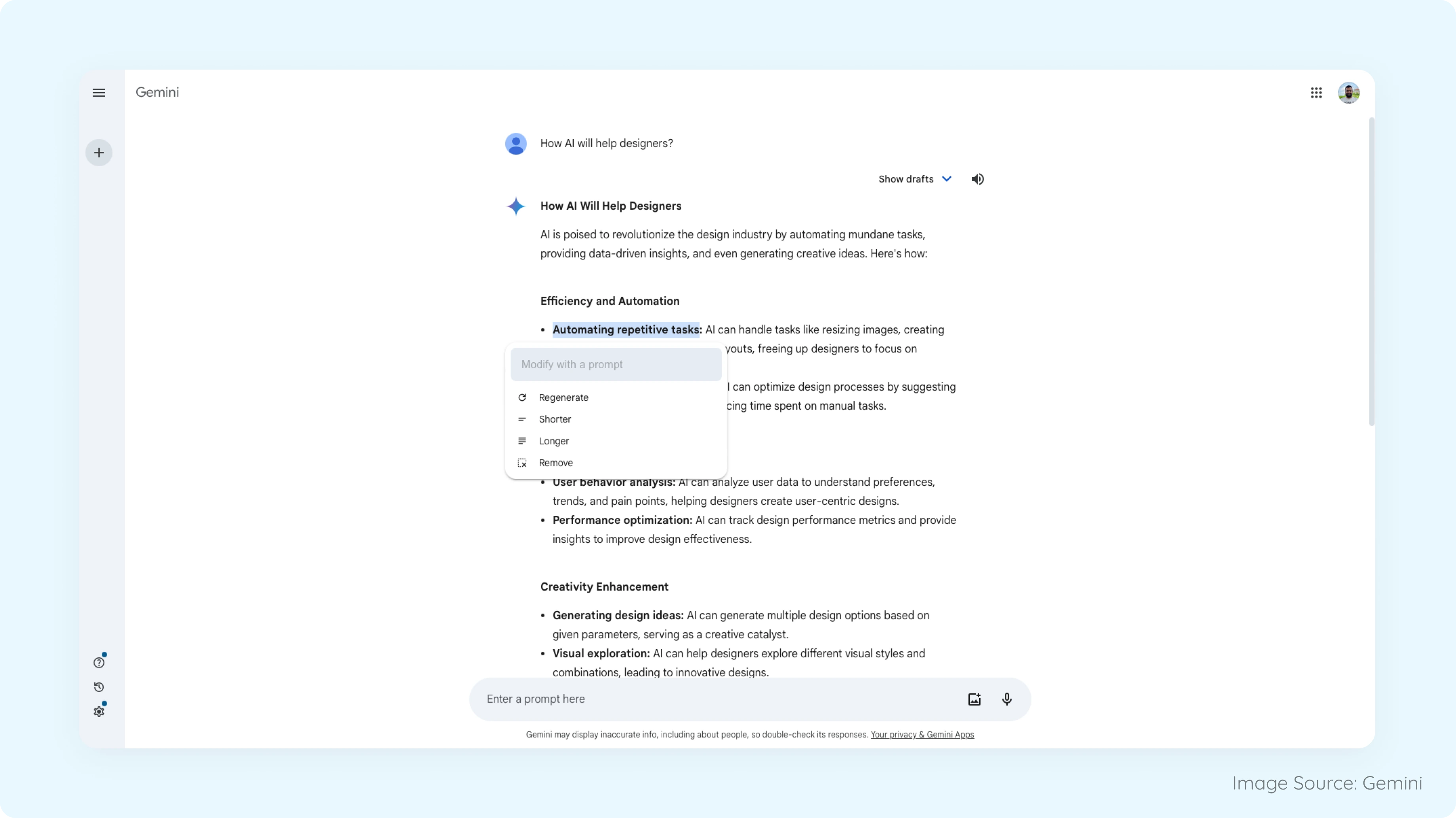
- 4.Uizard: Generates initial design mockups from sketches or text descriptions. Users can then refine these designs by tweaking layout elements, changing colors, adjusting typography, etc.
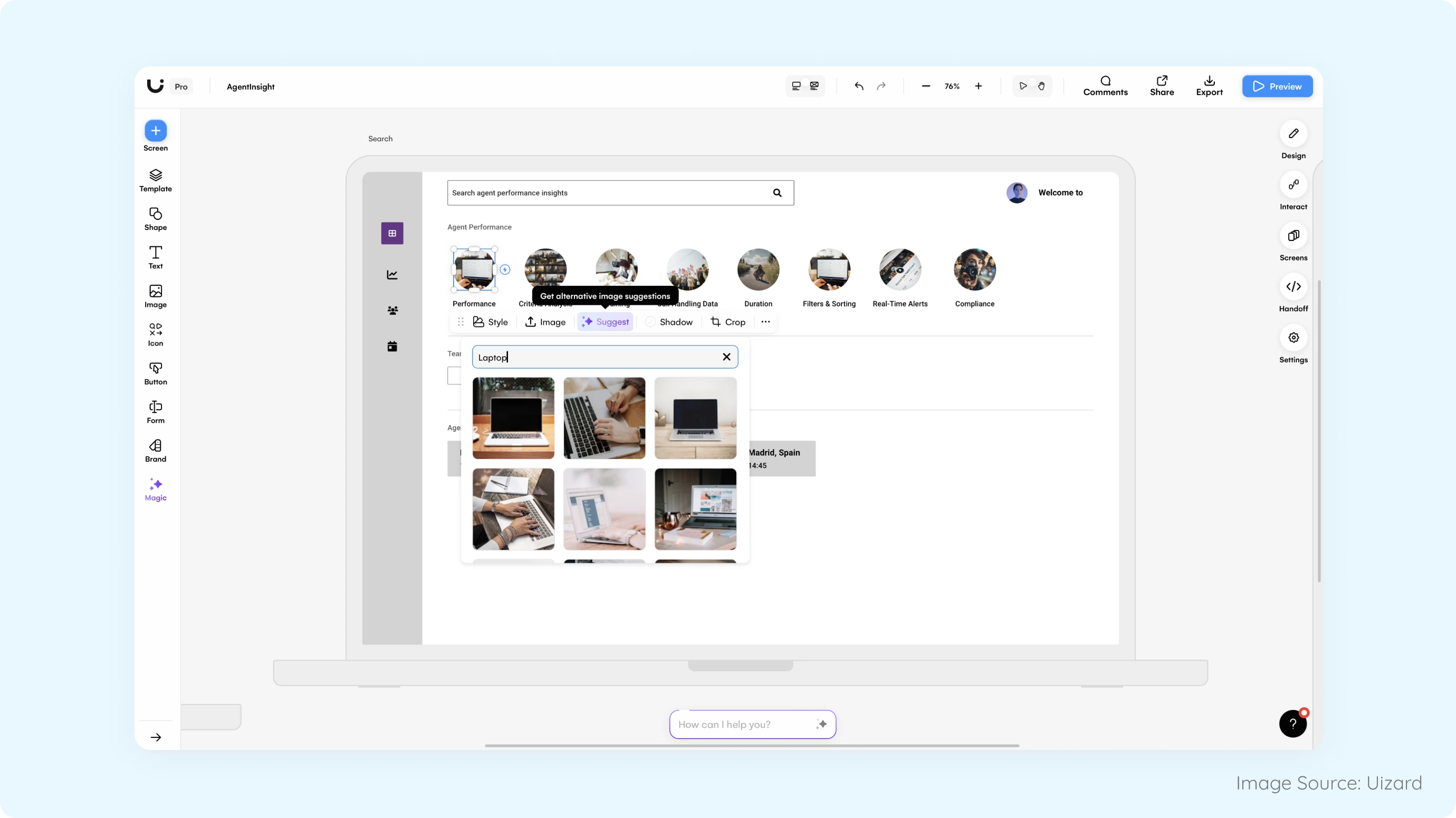
Integration into Workflow
- For UX Designers: Integrate intuitive menus and buttons that allow refinement without interrupting user flow.
- For Product Managers: Use refinement analytics to understand common adjustments users make, helping improve the underlying AI model.
- For Developers: Offer easy API hooks to customize refinement options based on application needs.
PATTERN 2
Human Verified vs AI-Generated

What is it?
Human Verified vs AI-Generated pattern ensures that the AI system behaves transparently and reliably, helps users understand how decisions are made, and why certain outputs are produced.
Why is it important?
To ensure that the users get the utmost clarity when interacting with AI systems and enable transparency in decision-making. It enhances user trust and encourages adoption by clearly communicating how the AI works.
Implementation Tips
- Design clear visual indicators (e.g., badges, icons, or color coding) to differentiate between AI-generated and human-verified content.
- Implement a system to assign confidence levels or accuracy scores to AI-generated content and provide easily accessible explanations of what these indicators mean.
- Allow users to filter or sort content based on verification status or confidence level.
- Include information on the verification process for human-verified content.
Healthcare use cases + Real life examples
- 1.Insurance Portal: An AI system for an insurance portal explains to users why certain applications are approved or denied, providing a clear breakdown of factors such as pre-existing diseases, type of plan, coverage benefits, waiting period, and more.
- 2.Diagnostics: A medical diagnosis AI shows patients the data used to reach its diagnosis, including relevant symptoms, tests, and historical records, so they can better understand the treatment recommendations.
- 3.NewsGuard: Provides trust ratings for news websites, offering insights into the credibility and transparency of sources.
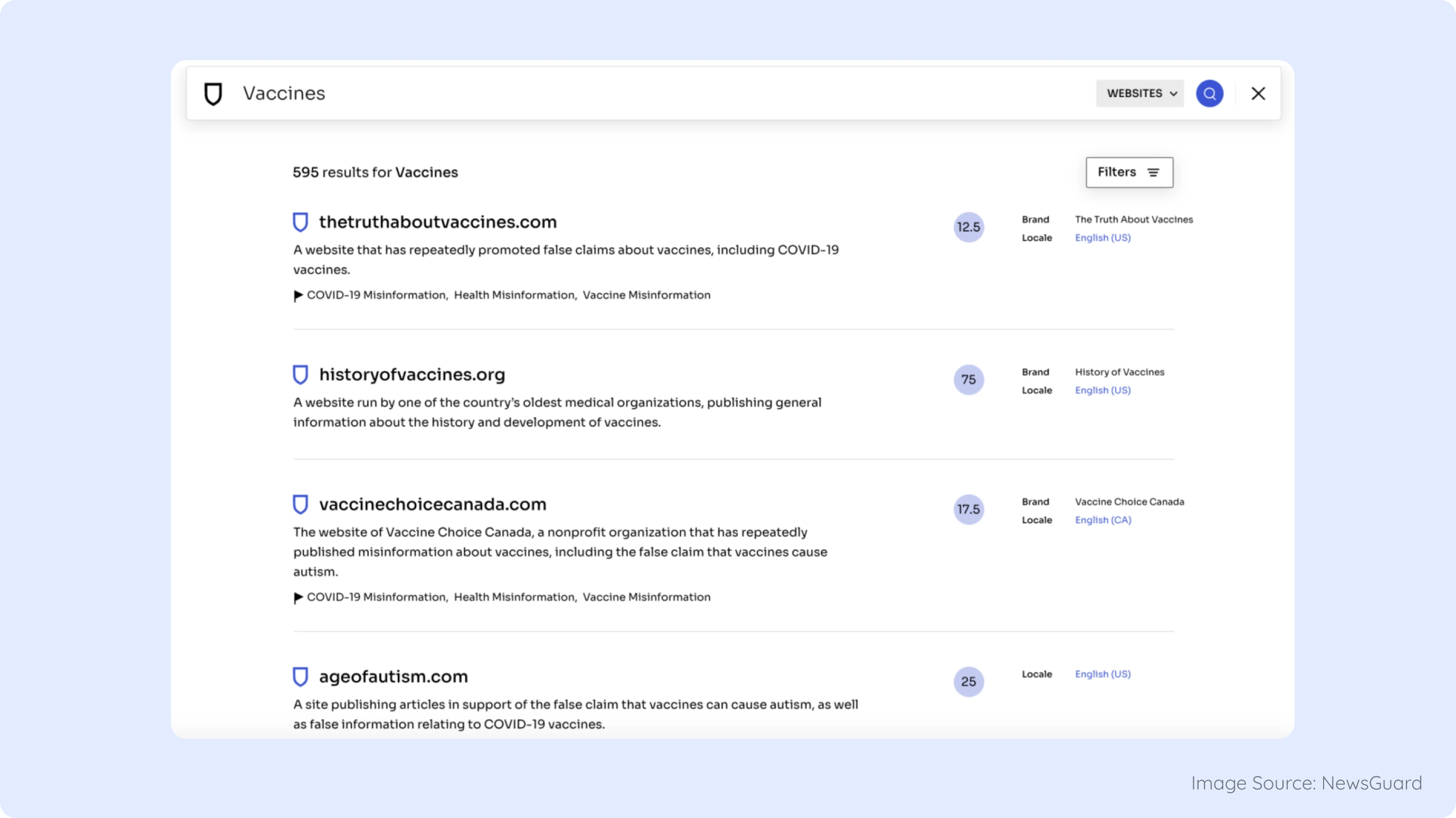
- 4. Assistance by Scite AI: Shows confidence scores of citations and whether a paper is supported, contradicted, or merely mentioned in other research.
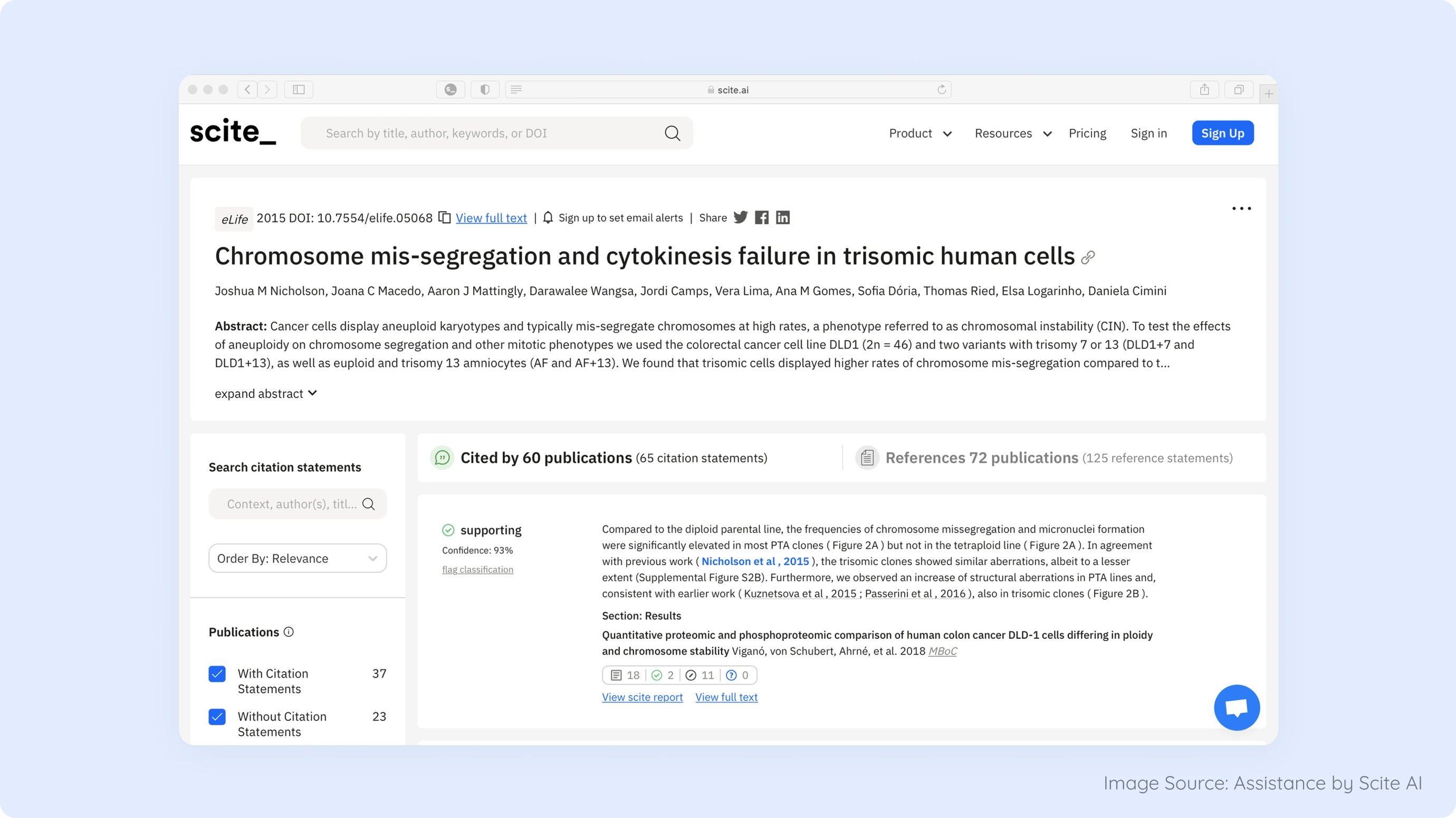
Integration into Workflow
- For UX Designers: Focus on providing user-friendly visualizations of AI decisions and data flow, ensuring that explanations are accessible and non-technical where possible.
- For Product Managers: Use trustworthiness metrics (e.g., user feedback on explanations) to measure the effectiveness of transparency features and make iterative improvements.
- For Developers: Implement mechanisms to log and explain AI decision-making processes, ensuring that this information is available in real-time and easy to integrate into user interfaces.
PATTERN 3
Scoping

What is it?
Scoping defines the scope of users’ queries, helping them narrow down results to improve the relevance and accuracy of AI-generated outputs. It allows users to tailor their queries by specifying parameters such as time frame, domain, or context, ensuring that the AI delivers more targeted and useful results.
Why is it important?
It helps users refine their AI queries by clearly defining the parameters and context. It saves time by avoiding irrelevant data and results. Narrowing the scope prevents information overload, helping users focus on the most pertinent data without being distracted by unnecessary details.
Implementation Tips
- Create intuitive interfaces for users to set query parameters (e.g., sliders, dropdown menus, checkboxes).
- Implement real-time filtering options for AI-generated results.
- Provide suggested scoping options based on the initial query and available data.
- Allow users to combine multiple scoping criteria for more precise results and offer the ability to save and reuse scoping preferences for future queries.
Healthcare use cases + Real life examples
- 1.Medical Diagnosis Assistance: A doctor using an AI tool for diagnosis can scope a query to focus on specific patient history, such as cardiovascular issues within the last two years, rather than the entire medical record, for quicker and more accurate insights.
- 2.Diagnostics: Drug Interaction Research: A pharmacist uses AI to investigate potential drug interactions but narrows the scope to specific drug categories or patient demographics (e.g., elderly patients with diabetes), ensuring the results are highly relevant.
- 3.Scite AI: Enables users to customize generated content based on specific parameters such as evidence source, year range, publication types, and response length.

- 4.Form.app: Allows users to set specific parameters and conditions within their forms, using filters and conditional logic to narrow down responses.
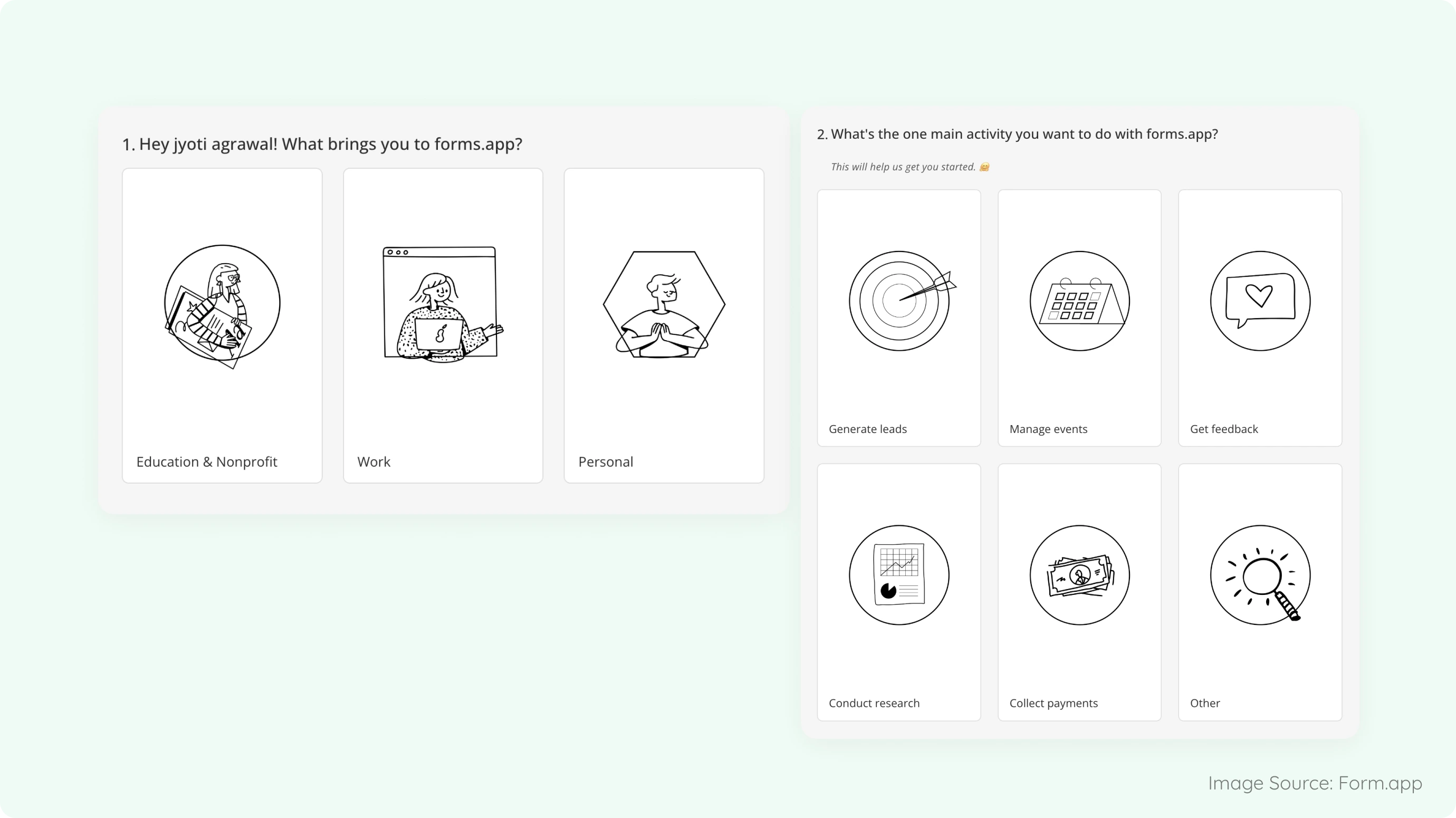
Integration into Workflow
- For UX Designers: Design intuitive scoping interfaces that allow healthcare professionals to easily set filters or constraints on data without overcomplicating the UI.
- For Product Managers: Collect data on how frequently users adjust scope parameters to better understand user preferences and common scopes in healthcare settings.
- For Developers: Implement adaptive scoping algorithms that allow the AI to automatically suggest scopes based on user behavior and context, making scoping faster and more efficient.
PATTERN 4
Prompt Presets & Templates

What is it?
Pre-defined prompts and templates to guide AI interactions and ensure more relevant outputs. The structured templates are designed to help users formulate queries, speed up the interaction process, and improve the quality of the results.
Why is it important?
Predefined prompts and templates ensure that queries are consistently structured, especially in environments where accuracy and standardization are critical. Users can select from a range of relevant prompts rather than drafting queries from scratch, saving time in urgent situations.
Implementation Tips
- Create a library of prompt presets categorized by task type or use case.
- Design customizable templates with placeholders for user-specific information. Provide clear descriptions or examples of how to use each preset or template.
- Allow users to save and share their own custom prompts or templates. Implement a system to suggest relevant presets based on user behavior or task context.
Healthcare use cases + Real life examples
- 1.Medical Data Analysis: A healthcare analyst uses a preset to query an AI tool for patient data trends related to diabetes management in a specific region. The preset includes parameters for patient demographics, HbA1c levels, and treatment adherence rates.
- 2.Patient Symptom Assessment: A general practitioner uses a template to enter patient symptoms into an AI diagnosis assistant. The template prompts for information on duration, severity, and other key variables such as family medical history and medications.
- 3.Uizard: Offers design templates and presets for wireframes, UI mockups, and prototypes.
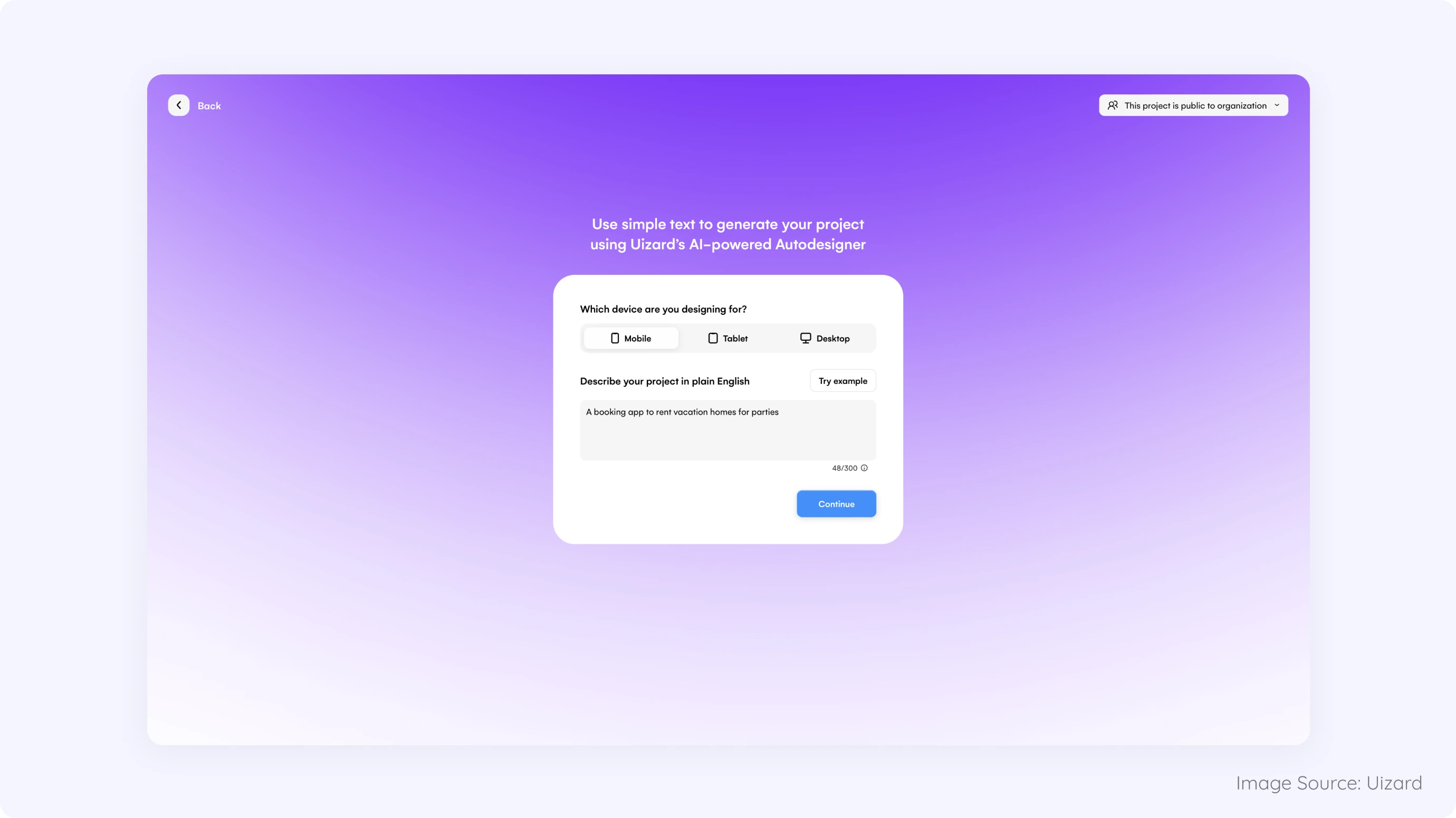
- 4.Lumen5: Provides video creation templates to turn blog posts or articles into videos.
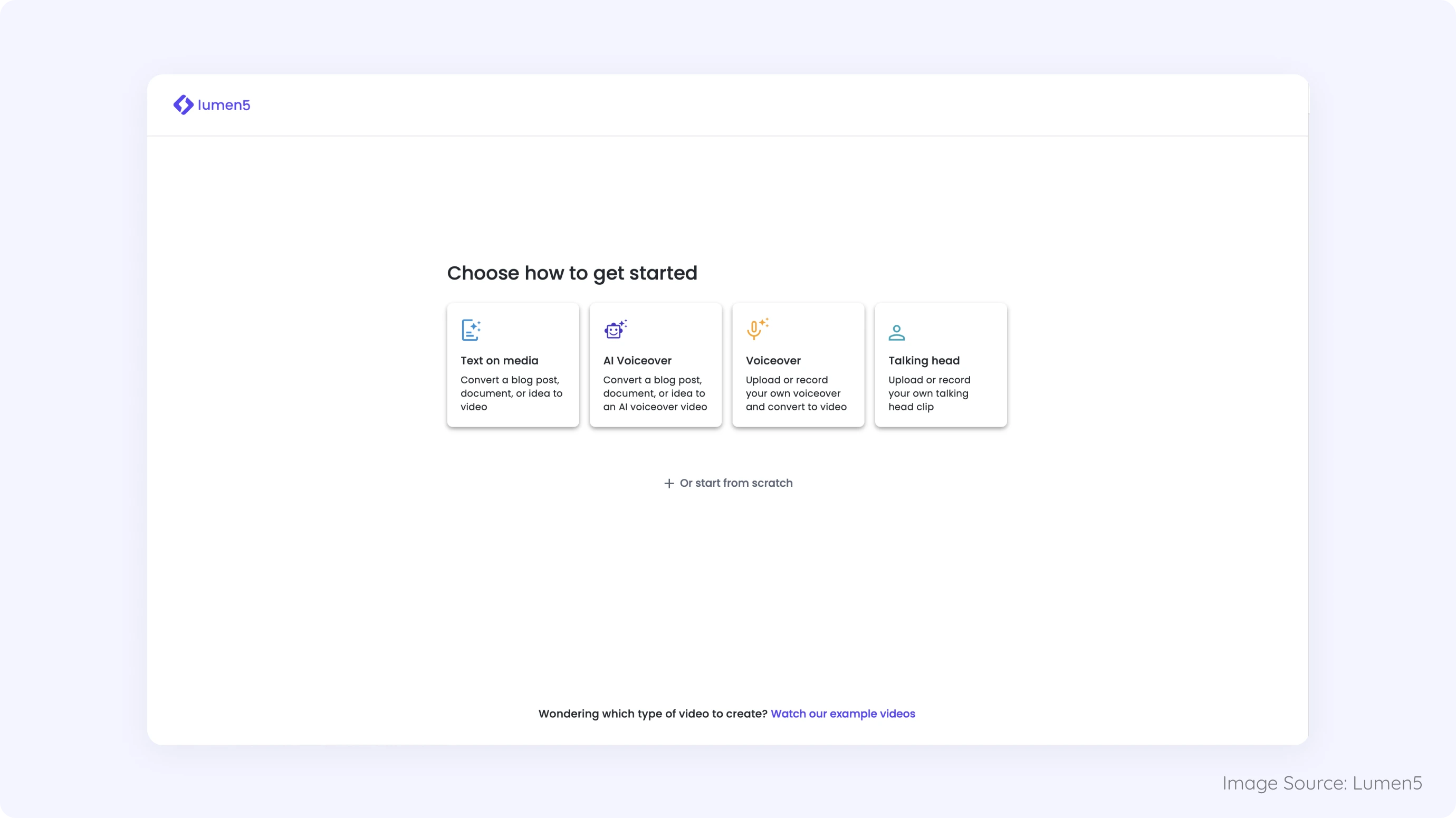
Integration into Workflow
- For UX Designers: Ensure that templates are easy to access and edit within the user interface, with simple options to add fields or remove irrelevant ones.
- For Product Managers: Analyze usage data to determine the most popular templates and prompts in healthcare settings, and optimize or expand these based on user feedback.
- For Developers: Build adaptive systems that allow users to create custom templates based on frequent queries, ensuring templates remain dynamic and useful over time.
PATTERN 5
Style Lenses or Temperature Knobs

What is it?
Style Lenses or Temperature Knobs allow users to adjust the style, tone, or creativity level of AI-generated content. It helps tailor AI responses to specific contexts or preferences by giving users control over how formal, concise, or imaginative the output is. Think of simplifying technical jargon for users or using more formal language in professional settings.
Why is it important?
It offers users flexibility in how AI content is presented, especially where different communication styles are required depending on the audience. This pattern ensures that the AI's output matches the tone and formality appropriate for the situation to enhance clarity and engagement.
Implementation Tips
- Create intuitive controls (e.g., sliders, toggles, or dropdown menus) for adjusting content characteristics.
- Offer preset styles or tones that users can select from (e.g., formal, casual, technical, creative).
- Allow for fine-tuning of specific aspects like creativity level, detail, or language complexity.
- Provide real-time previews of how adjustments affect the generated content.
- Consider implementing a "randomize" option for users who want to explore different styles.
- Ensure that the range of adjustments clearly demonstrates the system's capabilities.
Healthcare use cases + Real life examples
- 1. Patient Education: A doctor can adjust the tone of an AI-generated medical summary to make it more conversational and easy to understand for patients. For instance, shifting from technical jargon to plain language when explaining a diagnosis.
- 2.Clinical Research Reports: A researcher can increase the formality and conciseness of AI-generated content when summarizing findings for a peer-reviewed journal.
- 3.Grammarly: Offers options to adjust the tone (e.g., friendly, professional, persuasive) or rewrite (e.g., shorten, more detailed, professional) of the generated content.
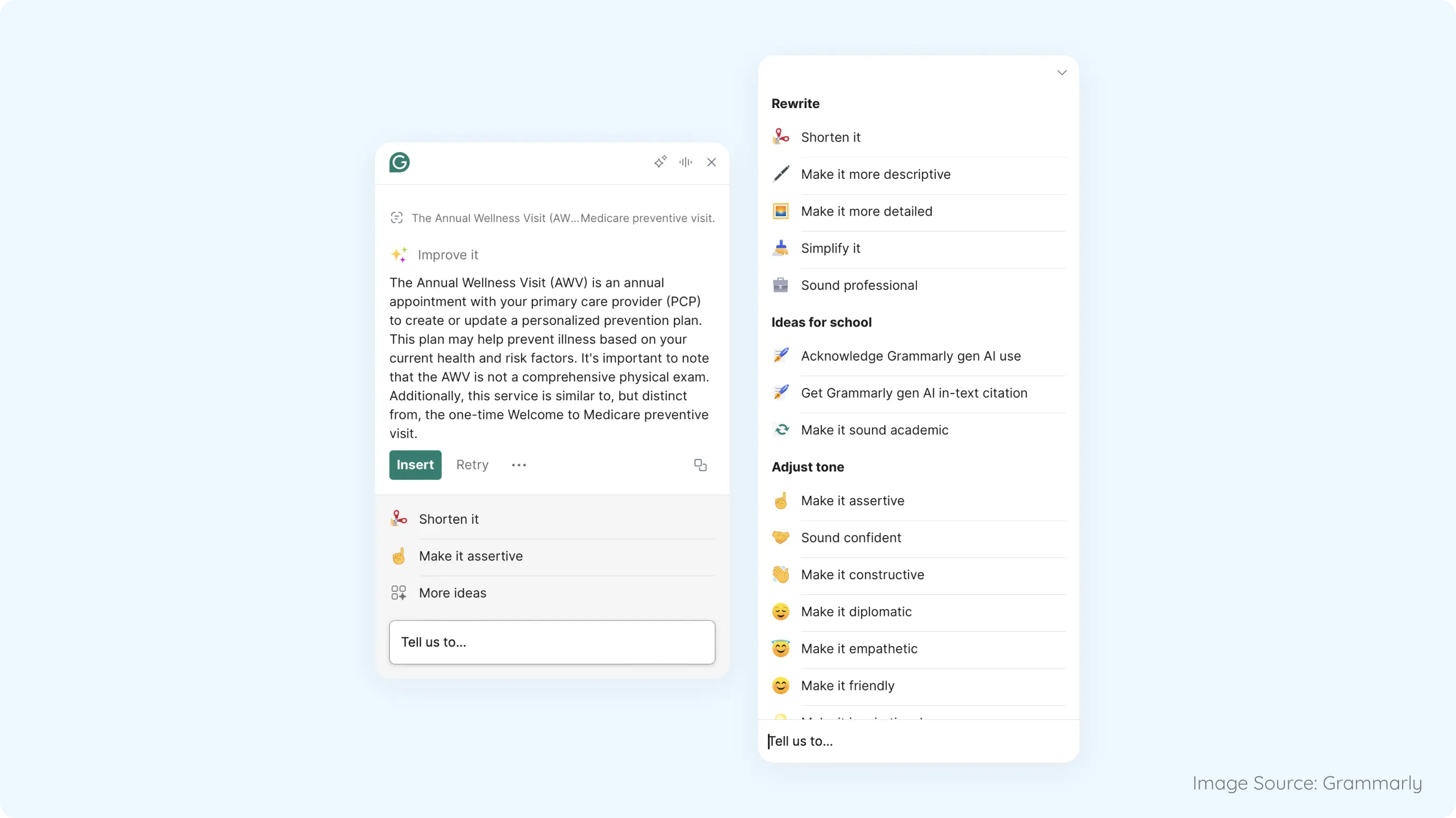
- 4.Murf.ai: Enables users to modify pitch, speed, and pause of audio, as well as emphasis and custom pronunciation in AI-generated voices.
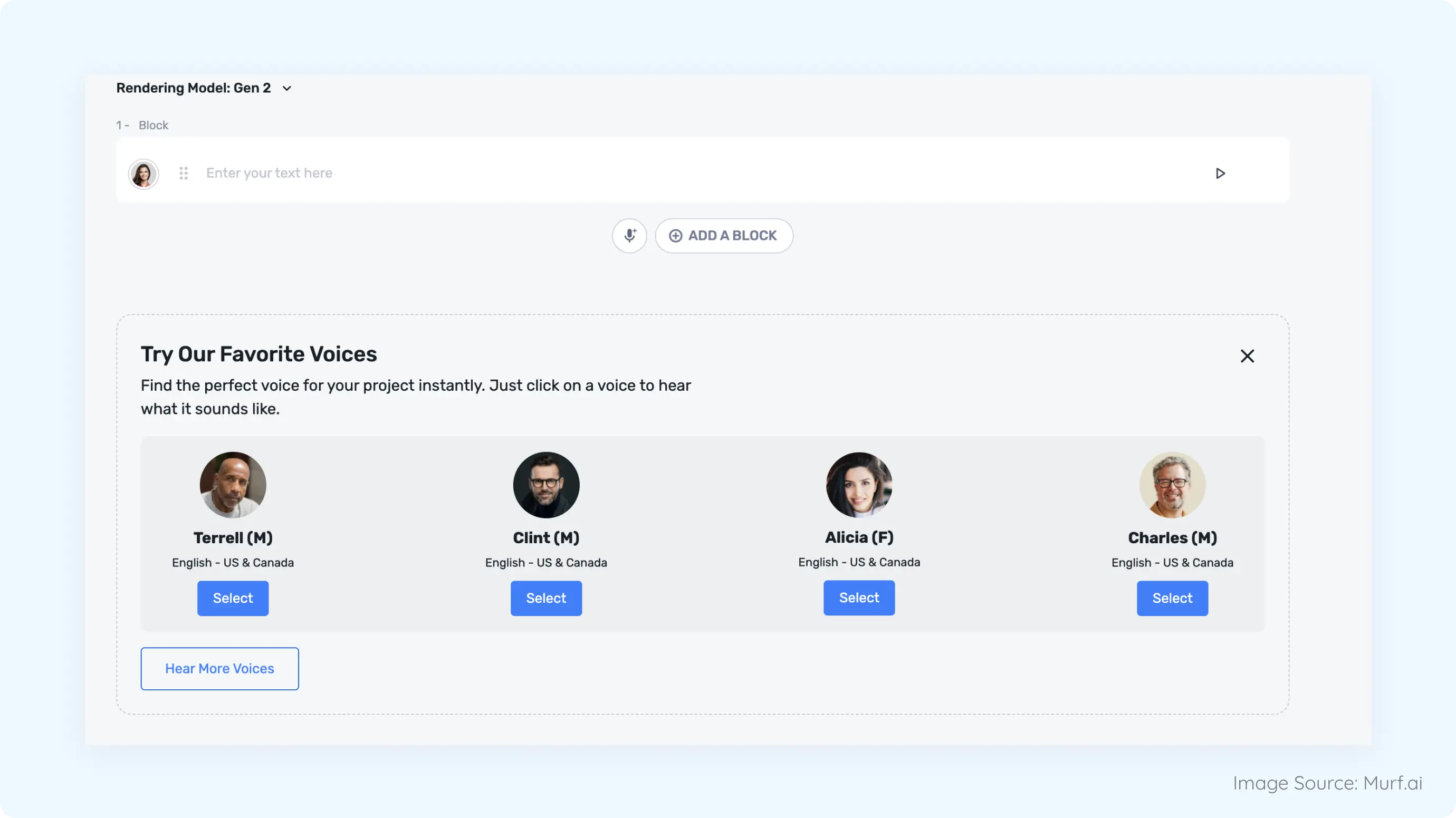
Integration into Workflow
- For UX Designers: Create intuitive temperature controls or sliders that allow users to easily adjust creativity and tone. Offer visual cues or sample text as the temperature or style changes.
- For Product Managers: Monitor how users adjust tone and creativity levels, using this data to optimize and refine default presets based on real-world preferences.
- For Developers: Implement real-time feedback as users adjust the temperature knob or style, so they can immediately see how their content changes and quickly find the right tone.
PATTERN 6
AI Daemons

What is it?
AI Daemons are background characters or processes that help explore AI output through different perspectives, such as critical, creative, or summarized views. They offer alternate viewpoints on AI-generated content, allowing users to see a range of interpretations or analyses.
Why is it important?
AI Daemons make interactions with AI more engaging and personalized and helps users explore and effectively refine AI-generated content. For instance, Critical Daemons help ensure accuracy and consistency in AI outputs by identifying gaps, errors, or risks that might otherwise be overlooked. Summarizing Daemons help simplify complex data for easier communication.
Implementation Tips
- Create distinct "personalities" or "daemons" with specific roles (e.g., critic, summarizer, creative explorer). Present the daemon's interpretations alongside or as an overlay to the original AI output.
- Allow users to invoke these daemons to process, reinterpret, and explain AI outputs.
- Enable users to switch between different daemon perspectives easily.
- Ensure daemons provide insights into why the AI-generated specific content.
Healthcare use cases + Real life examples
- 1.Treatment Options Exploration: A doctor exploring AI-recommended treatments can use a Critical Daemon to flag potential side effects or risks, a Summarizing Daemon to give a concise overview of key factors, and a Creative Daemon to propose alternative or experimental treatments based on emerging research.
- 2.Medical Research Assistance: A healthcare researcher uses multiple daemons to interpret clinical trial data. A Summarizing Daemon condenses thousands of data points into a digestible report, while a Creative Daemon suggests novel approaches to analyzing the data based on trends from other similar studies.
- 3.Maggie Appleton's concept of personalized demons that provide various interpretations or enhancements of AI-generated content. These demons can critique, synthesize, or summarize content differently, offering insights into the AI's reasoning.
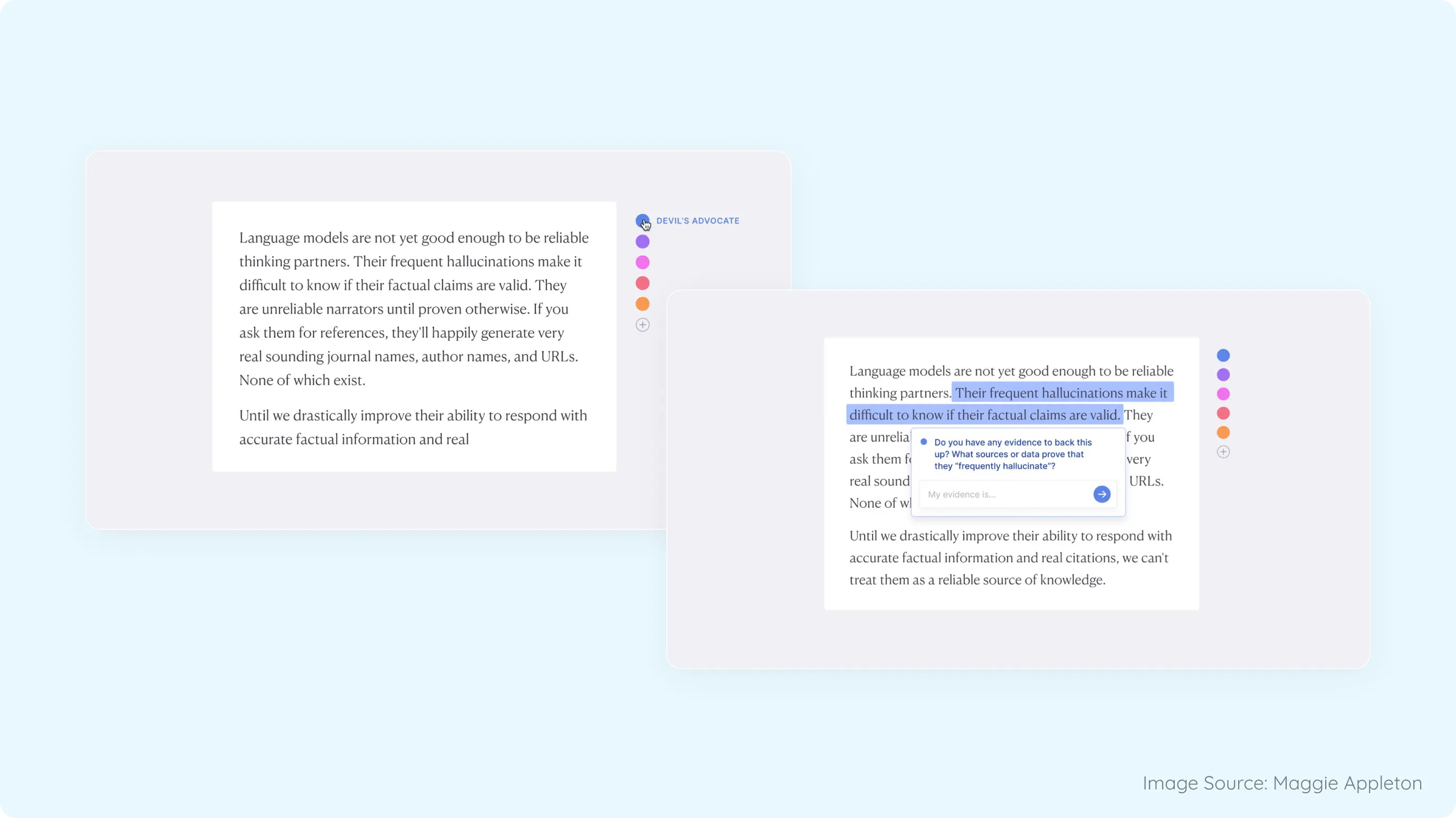
Integration into Workflow
- For UX Designers: Ensure daemon selection is intuitive and that users can easily switch between different daemons or combine them. Display daemon-generated insights clearly without overwhelming the user.
- For Product Managers: Analyze user interactions with daemons to see which combinations are most valuable in healthcare settings. Use this data to optimize daemon suggestions based on task or context.
- For Developers: Build daemons to operate seamlessly in the background, allowing them to refine content or offer alternate perspectives without requiring constant user interaction. Develop daemons that can learn from user feedback and evolve over time.
PATTERN 7
Branching

What is it?
Branching helps users explore cause and consequence chains by providing reasons and consequences for different claims or statements. It breaks down complex ideas into a series of steps, showing how one decision or event can lead to multiple outcomes, and helping users visualize potential cause-effect relationships, especially when making decisions or evaluating options.
Why is it important?
It provides the ability to explore potential outcomes and consequences of specific decisions or claims. It can be particularly useful for mapping out the effects of decisions, predicting outcomes, or identifying potential risks associated with certain actions.
Implementation Tips
- Create an interactive interface where users can select specific statements or claims. For each selected statement, offer options to explore "reasons" (causes) and "consequences".
- Present branching information in a hierarchical or tree-like structure. Allow users to continue exploring multiple levels deep into each branch.
- Provide clear navigation to move back up the chain or switch between different branches. Clearly show how different inputs or user behaviors lead to specific outputs.
Healthcare use cases + Real life examples
- 1.Treatment Decision-Making: A physician considers different treatment options for a patient with diabetes. Branching helps explore the consequences of each option, such as the short-term benefits of insulin therapy versus the long-term risk of developing hypoglycemia.
- 2.Preventive Care Planning: A healthcare administrator uses branching to visualize the effects of implementing different preventive care programs, such as the outcomes of increasing vaccinations versus expanding early screening programs, and the potential impacts on public health.
- 3.Maggie Appleton's example of exploring claims like “more men hold grandmaster chess rankings than women” by asking for reasons and consequences.
.webp&w=3840&q=100)
Integration into Workflow
- For UX Designers: Design an intuitive interface that allows users to explore branching paths visually, with the ability to expand or collapse details based on the user’s focus. Clear visual indicators (e.g., different colors for positive vs. negative consequences) will help guide users through complex chains.
- For Product Managers: Analyze common branches users explore and ensure the feature adapts to the specific decision-making needs of your users. This could involve refining branching suggestions based on common scenarios.
- For Developers: Implement dynamic branching algorithms that take into account real-time data, allowing the branching to evolve as new information is introduced.
PATTERN 8
Explainability Layers

What is it?
These are multiple layers of explanations that allow users to see how the AI reached a particular conclusion, providing detailed insights into the data sources, decision pathways, and reasoning steps that informed the AI’s recommendations or outputs.
Why is it important?
They provide clarity and transparency around AI decisions by breaking down the logic and data behind AI outputs. This is crucial for building trust in AI-assisted responses, outputs, or findings, ensuring that users can verify and understand the rationale behind the recommendations before acting on them.
Implementation Tips
- Create a hierarchy of explanation layers, from simple summaries to detailed technical explanations.
- Implement an interface that allows users to "drill down" into deeper layers of explanation.
- Use visualizations, natural language explanations, and data breakdowns as appropriate.
- Provide context-specific explanations for individual outputs (local explanations). Offer general explanations of the AI's overall decision-making process (global explanations).
Healthcare use cases + Real life examples
- 1.Diagnosis Explanation: A physician uses AI to help diagnose a patient with complex symptoms. The Explainability Layers allow the doctor to see which data points (e.g., lab results, symptoms) contributed most to the AI's diagnosis of lupus, providing confidence in the decision-making process.
- 2.Research Data Interpretation: A researcher uses AI to analyze trial data. The Explainability Layers break down the AI's analysis of large datasets, showing which variables were most influential in predicting outcomes.
- 3.Assistance by Scite AI: Helps researchers assess the trustworthiness of academic papers by showing citation contexts (whether a paper is supported, contradicted, or merely mentioned in other research).
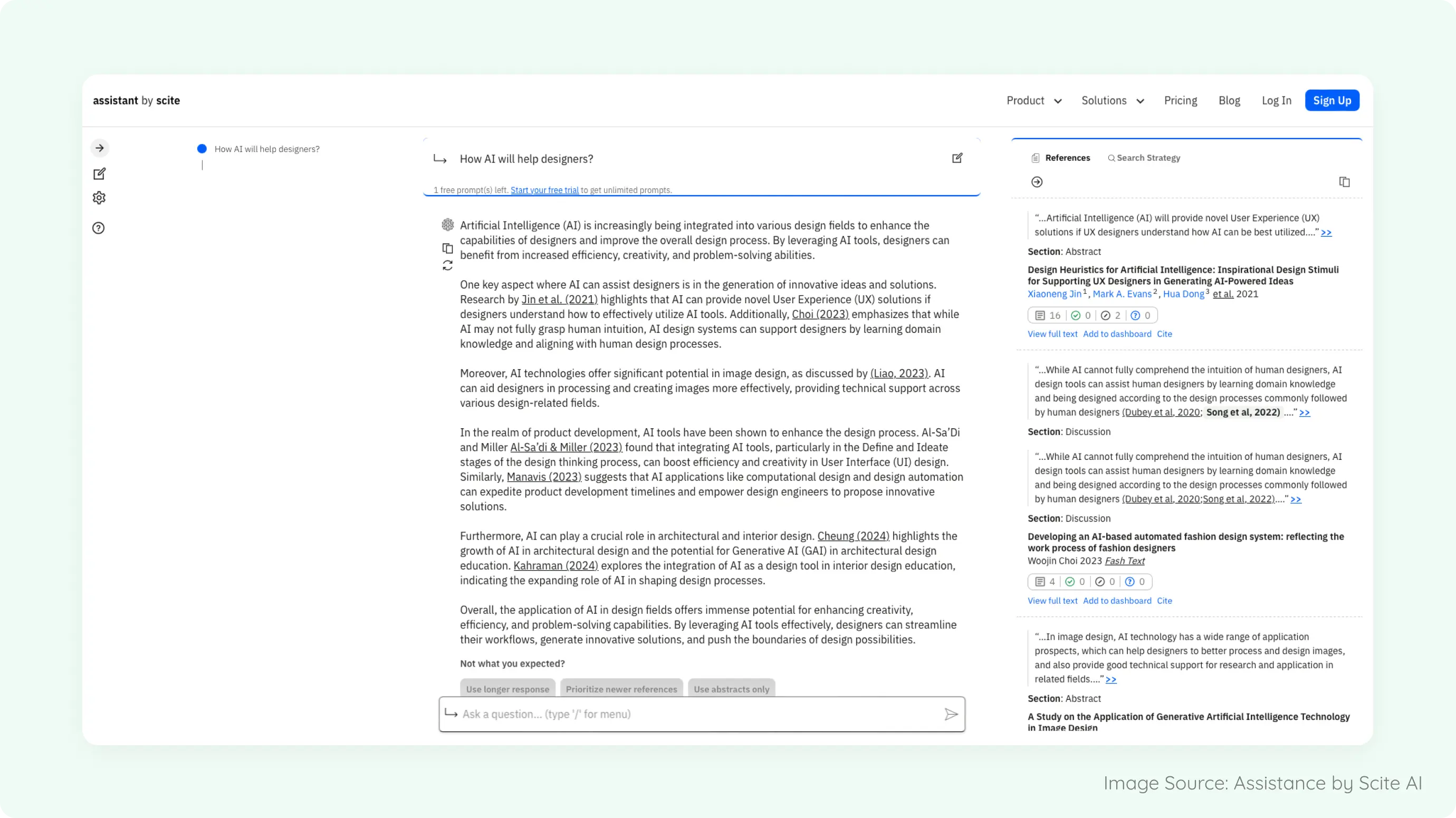
- 4.You.com: You.com’s YouChat AI summarization feature generates concise answers to user queries, often pulling from various sources. It accompanies these answers with explanations and direct links to the original content. This shows transparency in how the AI reaches its conclusions and offers users the opportunity to verify or explore the content further.

Integration into Workflow
- For UX Designers: Design the explanation layers to be easily navigable and visually clear. Use progressive disclosure so users can decide how much detail they want, making the experience smooth whether users need a quick summary or deep insights.
- For Product Managers: Ensure Explainability Layers are designed to meet the needs of different users. Pro users may need more technical breakdowns, while intermediate or new users might require simplified, high-level explanations.
- For Developers: Implement the layers in a way that is scalable to handle complex medical datasets and algorithms, while keeping explanations understandable and accessible. Ensure layers are flexible enough to cover different levels of complexity based on the healthcare context.
PATTERN 9
User-Driven Training

What is it?
User-driven Training enables users to actively train the AI by providing granular feedback on outputs. This feedback loop helps the AI improve its future outputs and personalizes the user experience. It helps fine-tune AI models based on real-world experiences and preferences, ensuring the AI adapts to the specific needs of users over time.
Why is it important?
It lets users refine and customize AI behavior through active interaction and feedback. This ensures that AI systems learn from users’ expertise and organizational workflows, leading to more accurate, personalized and context-sensitive AI outputs.
Implementation Tips
- Create simple, accessible feedback mechanisms for individual outputs (e.g., thumbs up/down, star ratings, or more detailed options).
- Implement both user-initiated (G15-A) and system-prompted (G15-B) feedback opportunities.
- Design feedback interfaces that allow users to specify what aspects of an output they liked or disliked.
- Use collected feedback to retrain or adjust the AI model for personalized experiences.
- Provide transparency about how user feedback influences the system.
Healthcare use cases + Real life examples
- 1.Clinical Diagnosis Feedback: A physician uses AI to assist in diagnosing patients. After receiving an AI-generated diagnosis, the doctor provides feedback, indicating that a specific condition (e.g., chronic kidney disease) was missed due to certain comorbidities. The AI uses this feedback to improve future diagnoses by refining its decision-making model for similar cases.
- 2.Treatment Plan Personalization: A hospital’s AI suggests standard treatment plans for patients with Type 2 diabetes. A healthcare provider customizes a patient's plan based on dietary preferences or lifestyle factors and provides feedback on how the AI should adjust similar recommendations in the future.
- 3.Claude AI: Offers a simple thumbs up or thumbs down option for users to quickly express whether they found the specific response helpful.

- 4.ChatGPT: Presents two response options and asks the user to choose one, helping it learn and tailor future responses more effectively.
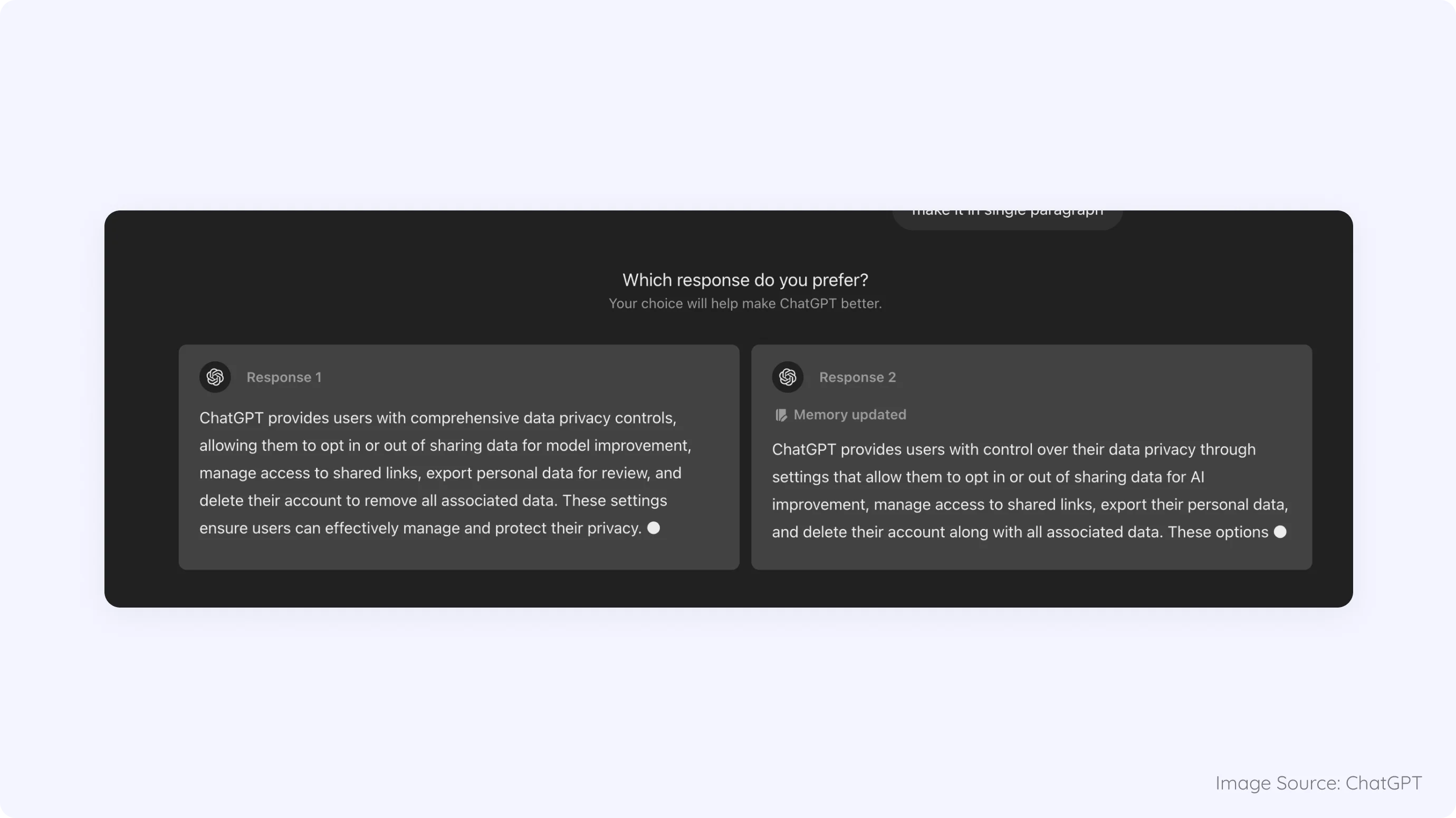
Integration into Workflow
- For UX Designers: Create a streamlined interface that allows users to provide granular feedback easily, with options to rate AI outputs, flag errors, or offer corrections. Design it to ensure that both novice and expert users can participate in training the AI system.
- For Product Managers: Monitor the feedback loop to identify common patterns in user feedback, which can inform further model training or feature enhancements. Ensure the system allows feedback to be aggregated and prioritized based on relevance.
- For Developers: Implement algorithms that allow the AI to learn iteratively from user feedback. Build in safe learning mechanisms to ensure that user-driven training doesn’t result in harmful modifications to the AI model.
PATTERN 10
Predictive Assistance

What is it?
Predictive Assistance enables the system to anticipate user needs and offer proactive assistance through the AI interface. It leverages historical data, real-time inputs, and contextual clues to predict what the user might require next and proactively provide solutions.
Why is it important?
To reduce cognitive load on users by offering timely suggestions and support, streamlining workflows, and improving efficiency. It empowers users by providing relevant insights and tools before they explicitly ask, for example, forgotten passwords or missed steps, enabling them to focus more on the task at hand.
Implementation Tips
- Analyze current user context and task to identify opportunities for assistance. Leverage recent interaction history to inform predictions. (Refer to guideline 12)
- Develop algorithms that can predict user needs based on contextual and historical data.
- Design an interface that presents contextually relevant suggestions unobtrusively.
- Provide clear, actionable suggestions that users can easily accept or dismiss.
- Implement a feedback loop to improve the accuracy of predictions over time.
Healthcare use cases + Real life examples
- 1.Medical Documentation: As a doctor conducts a patient consultation, the system predicts and suggests the necessary medical codes and documentation that will be needed for billing or record-keeping, based on the diagnosis and treatment discussed. This reduces time spent on post-consultation administrative tasks.
- 2.Appointment Scheduling: For patients with chronic illnesses, the system predicts the need for follow-up appointments based on previous treatment schedules and offers proactive appointment booking suggestions, ensuring that care remains consistent and timely.
- 3.Gamma: When users begin creating a presentation, it suggests relevant content, layouts, and even citations based on the topic.

- 4.You.com: Uses AI to anticipate user needs and offer tailored suggestions, with AI Modes such as Genius and Research enhancing its predictive capabilities.
.webp&w=3840&q=100)
Integration into Workflow
- For UX Designers: Design the interface so that proactive suggestions are presented in a non-intrusive way. Suggestions should appear at key moments but allow users to override them easily without disrupting their workflow.
- For Product Managers: Track which predictive suggestions are most used or dismissed to refine the system’s predictive models and improve the relevance of the AI’s assistance in real-time environments.
- For Developers: Build models that learn over time from user interactions to improve the accuracy of the AI's predictions. Ensure these models can adapt to different user behaviors and medical specialties, providing customized assistance based on individual workflows and preferences.
PATTERN 11
Context Retention

What is it?
Context Retention allows AI systems to remember previous interactions with users and use that information to make current conversations more coherent and relevant.
Why is it important?
To reduce the need to re-enter or repeat information, saving time and improving the flow of communication and decision-making. Provide more personalized and coherent responses, making interactions more user-friendly and relevant based on past interactions.
Implementation Tips
- Implement a short-term memory system to retain recent conversation history.
- Develop algorithms to analyze and extract relevant information from past interactions.
- Design the system to reference and incorporate the previous context in generating responses.
- Implement mechanisms to forget or deprioritize outdated or irrelevant information. Provide users with options to reset context if needed.
Healthcare use cases + Real life examples
- 1.Patient Follow-Up Discussions: A patient uses an AI chatbot for health consultations about managing chronic conditions, such as diabetes. The AI remembers details from previous sessions—such as the patient’s medication regimen, diet changes, and recent lab results—so it can offer personalized advice and follow-up care without asking the patient to repeat the same information.
- 2.Administrative Workflow Continuity: A hospital administrator uses an AI chatbot to streamline staff scheduling and equipment management. The AI retains data from previous interactions, such as preferred staff rotations or past issues with equipment shortages, ensuring that future interactions build on these insights to optimize resource allocation without needing the same inputs again.
- 3.DiveDeck.AI: Uses a combination of contextual memory and data analysis to retain and apply information from past interactions. It manages session details in real time and preserves essential user data over longer periods to maintain conversation coherence and relevance.
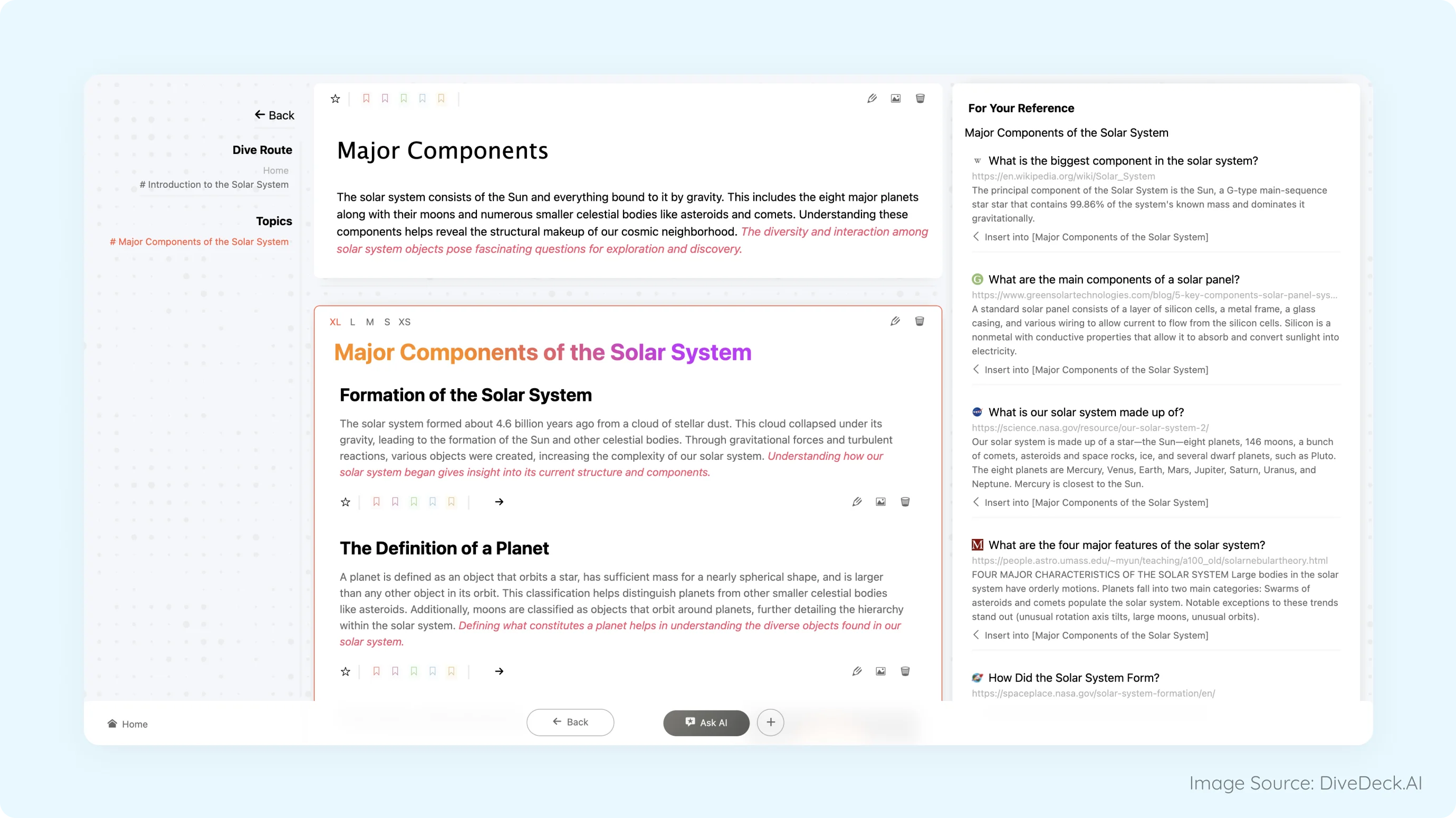
- 4.Microsoft Copilot: Retains context from previous interactions using advanced AI models that manage session details and long-term memory. It analyzes user data and behavior to adapt and personalize responses, ensuring that each interaction builds on the last.

Integration into Workflow
- For UX Designers: Ensure that the conversational history is presented intuitively. Design an interface that allows users to easily view and manage stored context from past interactions without overwhelming them with too much detail.
- For Product Managers: Monitor how frequently context retention improves efficiency and user satisfaction. Implement feedback mechanisms that allow users to flag inaccuracies or clear old information when necessary.
- For Developers: Implement secure storage for conversational context and ensure data encryption to protect sensitive information. Develop algorithms that can prioritize which parts of the conversation to remember and which can be safely discarded after interactions.
PATTERN 12
Data Privacy Controls

What is it?
It helps users manage and customize their data privacy settings and ensure compliance with regulations and other legal requirements. It strengthens trust between users and the AI system by giving them greater transparency and control.
Why is it important?
To enhance trust between users and AI systems by giving users control over how their data is managed, especially where the sensitivity of personal information is paramount.
Implementation Tips
- Create a dedicated privacy settings interface.
- Offer granular controls for different types of data and system features.
- Implement clear opt-in/opt-out mechanisms for data collection and use.
- Provide options to export or delete user data.
- Ensure privacy settings are easily accessible and modifiable.
Healthcare use cases + Real life examples
- 1.Patient Data Access Control: A patient using an AI-driven health app wants to restrict access to their mental health history while allowing their primary care provider to view data related to chronic disease management. The patient uses the Data Privacy Controls to fine-tune what information each healthcare provider can access.
- 2.Medical Research Participation: A hospital uses an AI system to analyze patient data for research purposes. Patients can use privacy controls to opt in or opt out of sharing their data for research, ensuring their preferences are respected while contributing to medical advancements if they choose.
- 3.Perplexity: Offers an "AI Data Retention" setting, giving users control over whether their interaction data is retained and used for improving AI models.
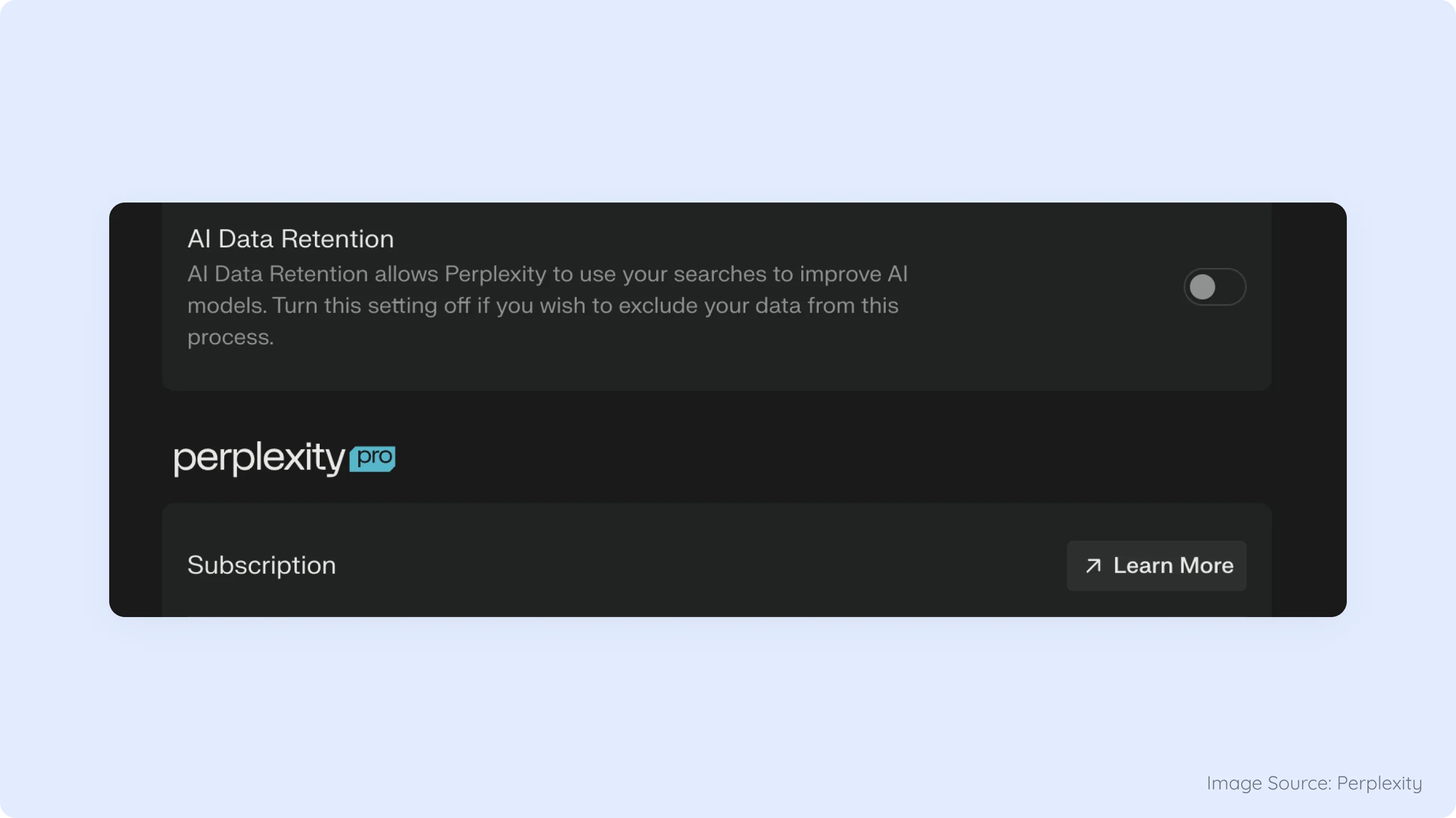
- 4.ClickUp Brain: Includes "Private Attachments" and "Block Public Sharing" features to limit access to sensitive information within the workspace.

Integration into Workflow
- For UX Designers: Design clear and intuitive privacy settings interfaces that allow users to easily view and modify their data preferences. Ensure the interface explains what each privacy setting does and why it matters, where data sensitivity is high.
- For Product Managers: Track which privacy controls users frequently adjust and which settings are rarely used. Use this data to make informed decisions about how to simplify and improve privacy management without compromising security.
- For Developers: Implement strong encryption and access control mechanisms to protect the data managed through privacy settings. Ensure the system complies with regulatory frameworks and incorporates mechanisms for data deletion and retention based on user preferences.
PATTERN 13
Error Recovery

What is it?
Error Recovery offers users mechanisms to easily recover from errors, missteps, or unintended actions while interacting with AI systems by providing clear paths to undo actions, fix mistakes, or clarify misunderstandings.
Why is it important?
Enable users to quickly resolve mistakes, maintain workflow continuity, and prevent critical errors from causing lasting problems. Knowing that errors can be easily corrected encourages users to explore AI systems without fear of making irreversible mistakes, boosting adoption and trust in AI-driven solutions.
Implementation Tips
- Design clear and accessible undo/redo buttons or commands.
- Implement a history or versioning system to allow reverting to previous states.
- Create informative error messages that explain what went wrong and how to fix it.
- Develop guided workflows for recovering from complex errors.
- Allow users to manually override or correct AI decisions or actions when appropriate.
Healthcare use cases + Real life examples
- 1.Patient Data Entry Correction: An AI-generated progress note can mistakenly record incorrect patient vitals into the electronic health record (EHR) system. The Error Recovery feature allows the practitioner to easily correct the mistake by providing an undo button or an option to verify and update the information before it is saved permanently in the system.
- 2.Miscommunication in AI Chat: A patient uses an AI-powered chatbot for health advice but enters incomplete or incorrect information about symptoms. The system provides a way to clarify inputs, allowing the patient to rephrase or add missing details. This ensures the AI responds with more accurate advice without requiring the patient to restart the conversation.
- 3.Grammarly: Offers "Undo" and "Redo" options and a "Version history" feature. These capabilities enable users to easily reverse or reapply changes, access earlier document versions, and restore content when necessary.
.webp&w=3840&q=100)
- 4.Canva: Provides a "Reset adjustments" button that allows users to quickly revert any changes made to image settings like brightness, contrast, highlights, and shadows, restoring the image to its original state.
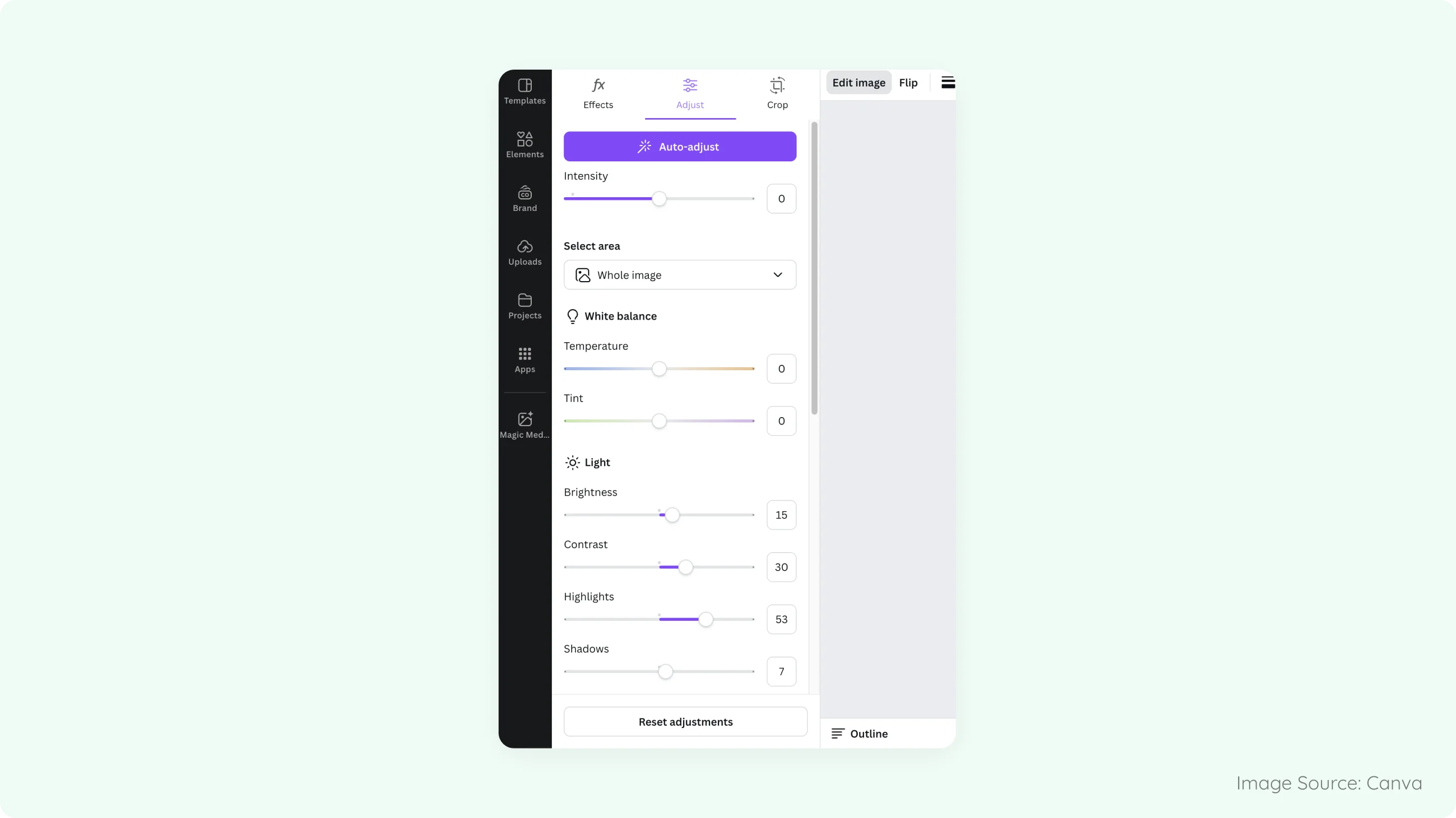
Integration into Workflow
- For UX Designers: Design clear and intuitive interfaces with easy-to-find undo/redo buttons or recovery options. Ensure that error messages and recovery pathways are presented in a way that doesn’t disrupt the user’s workflow or create frustration.
- For Product Managers: Track common error points within the system to identify areas where users frequently require recovery assistance. Use this data to improve the user experience and reduce the likelihood of future errors.
- For Developers: Implement error detection algorithms that intelligently recognize potential mistakes in real time and offer appropriate recovery mechanisms. Ensure that error recovery features comply with data management standards.
PATTERN 14
Assistant Pattern

What is it?
The Assistant Pattern provides proactive guidance by autonomously offering insights, explanations, and suggestions based on the user’s current actions or data inputs. It provides real-time suggestions or alerts, anticipating users’ needs and guiding them toward critical decisions without requiring specific requests for assistance.
Why is it important?
It streamlines workflows and reduces cognitive load by providing insights without explicit prompts, allowing users to focus on critical tasks without pausing to seek out information. It empowers users to make more informed decisions, benefiting from real-time insights based on data, history, and current trends.
Implementation Tips
- Develop algorithms to identify key insights or explanations relevant to the user's task.
- Design an interface that presents these insights unobtrusively alongside primary content.
- Implement natural language generation to provide clear, concise explanations and contextual information.
- Create a system for prioritizing which insights to show based on relevance and importance.
- Allow users to easily access more detailed explanations of why certain information was provided if desired.
Healthcare use cases + Real life examples
- 1.Medication Interaction Alert: A doctor prescribes a new medication for a patient using an AI-assisted EHR. The AI autonomously alerts the doctor about potential drug interactions with the patient's current medication, ensuring that the doctor has all the necessary information to adjust the prescription accordingly.
- 2.Proactive Health Monitoring: A patient wearing a smart health device receives autonomous insights from the AI assistant about elevated blood pressure trends over the past few days. The system suggests scheduling a follow-up appointment with their healthcare provider and offers explanations about potential causes.
- 3.Fathom: Automatically analyzes and summarizes open-ended data, like customer feedback, guiding users to key insights without needing manual input. It identifies trends, emotions, and themes, making it easy to understand what drives opinions and behaviors.
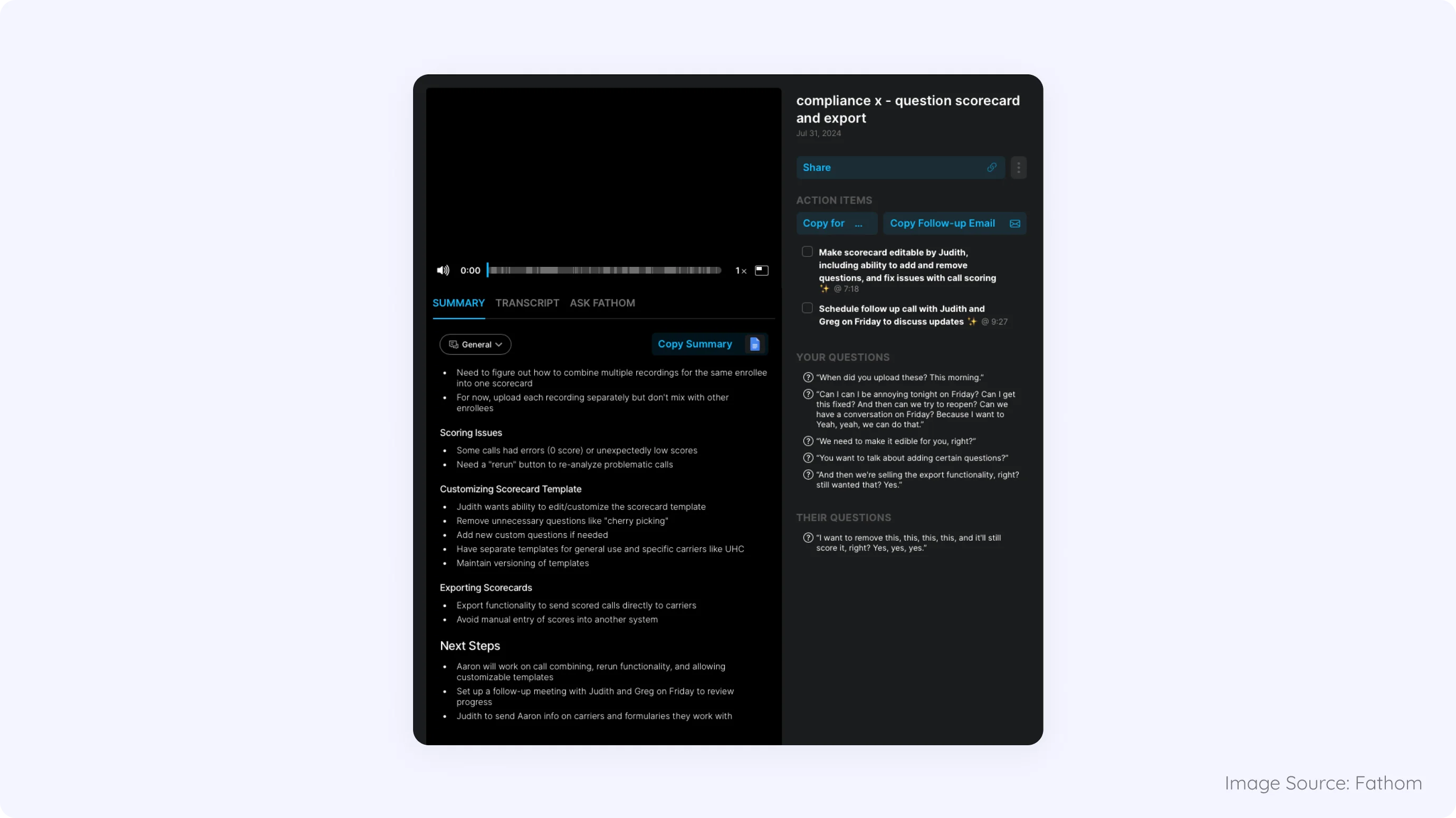
- 3.Research Rabbit: Autonomously guides users by analyzing research data and suggesting related papers, themes, and connections in real-time, helping users uncover insights without needing to request specific assistance.

Integration into Workflow
- For UX Designers: Design the assistant’s suggestions to be easily noticeable but non-intrusive, with clear explanations attached. Incorporate features that allow users to view or dismiss suggestions as needed without disrupting their workflow.
- For Product Managers: Track the effectiveness of the assistant’s insights and recommendations by monitoring how often users follow the AI’s suggestions. Use this data to fine-tune the assistant’s behavior and ensure that it provides relevant, actionable insights.
- For Developers: Ensure that the assistant’s algorithms are trained to recognize key contextual moments during the user’s workflow and can adaptively deliver insights based on individual use cases, especially where timing and context are crucial.
These 14 patterns are the building blocks for creating AI that’s intuitive, reliable, and user-friendly, much like how UI components serve as integral elements in the design of interfaces that leverage AI technologies to enhance user interaction. They simplify development, address user needs like transparency, trust, and control, and make AI a help, not a hindrance.
Additionally, tools like a UI generation platform facilitate rapid design ideation by allowing users to input text prompts that result in generated, editable, high-fidelity wireframes.
These patterns are essential to build smarter, more efficient AI systems that increase user trust and adoption – especially in industries like healthcare, finance, and education.
The future of AI is how well it fits into human workflows, delivering real value. These patterns are your roadmap to making that future happen.
Table of Content
User-Centric, Scalable Solutions That Are Secure & Compliant
Telehealth Integration in EHR to Assist Overburdened Providers
Improved patient care by merging safety, communication, and real-time tools for providers:appointment alerts, pre-visit patient review, and live translation/transcription.
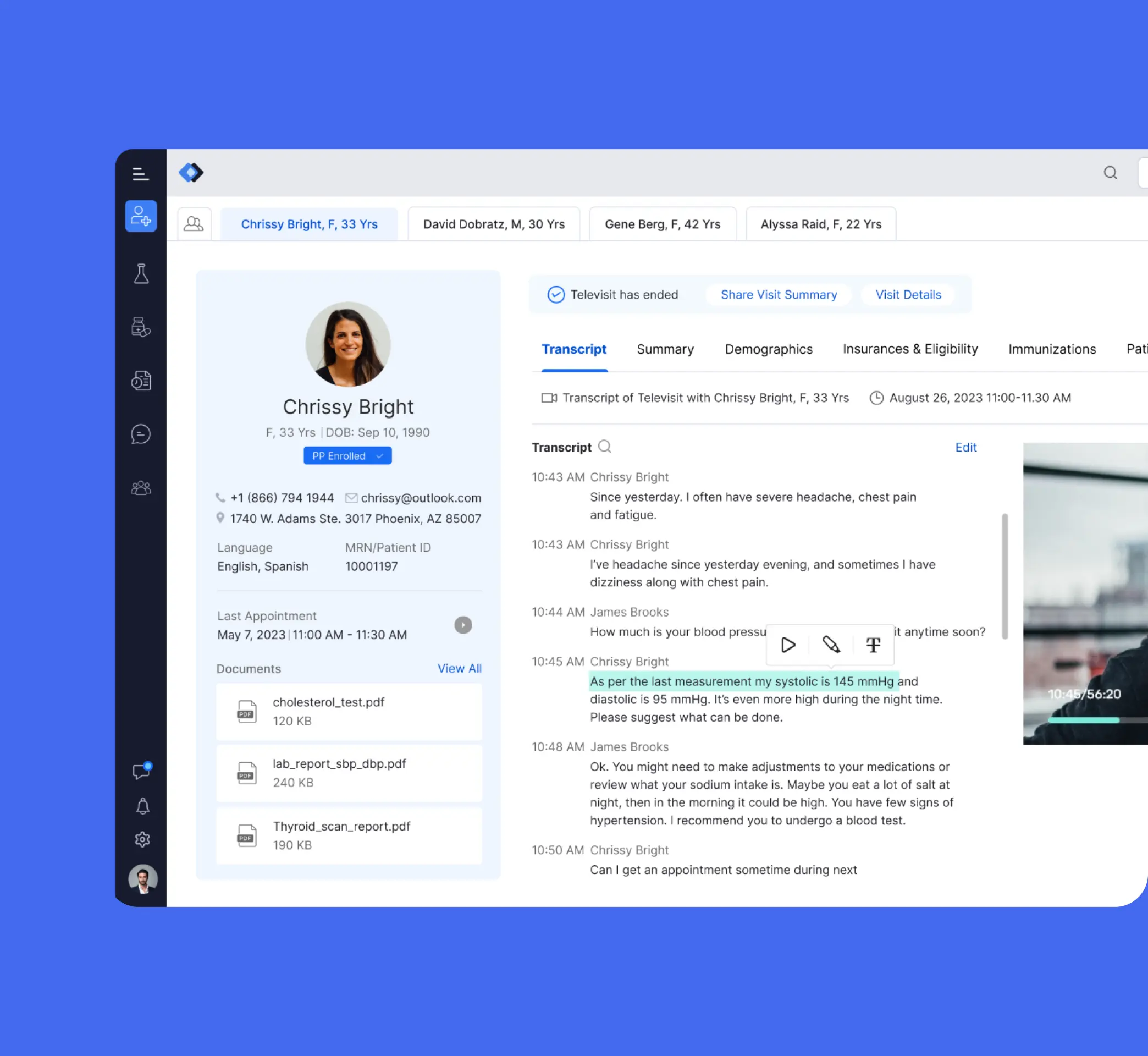
Ready to Build a Scalable UX Practice?
Our embedded team model empowers you to transition from tactical UX fixes to a fully scalable, strategic UX practice - aligned with your business goals and built for healthcare's unique challenges.
QUICK LINKS
VERTICALS
FIND US AT
INDIA
6/8, Kumar City, Wadgaon Sheri, Pune 411014

© 2025 Koru UX Design LLP




